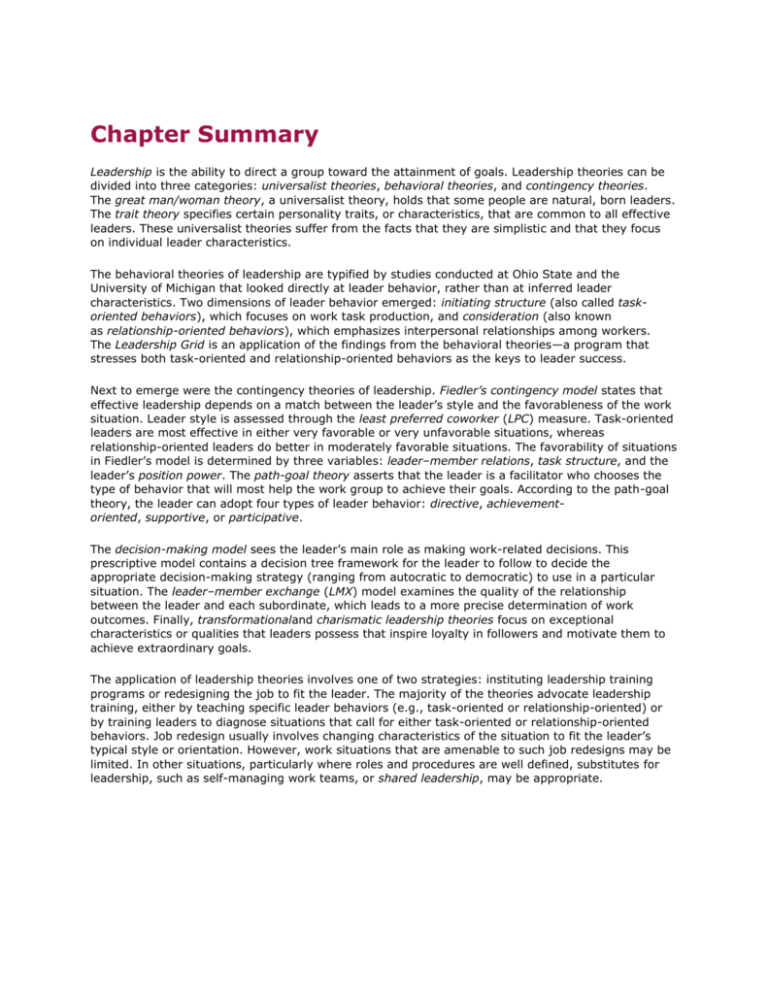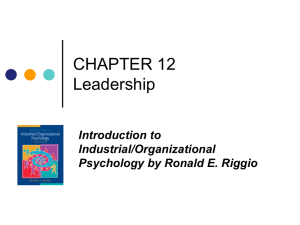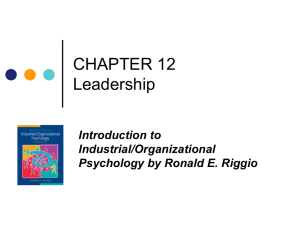Chapter 13 Summary
advertisement

Chapter Summary Leadership is the ability to direct a group toward the attainment of goals. Leadership theories can be divided into three categories: universalist theories, behavioral theories, and contingency theories. The great man/woman theory, a universalist theory, holds that some people are natural, born leaders. The trait theory specifies certain personality traits, or characteristics, that are common to all effective leaders. These universalist theories suffer from the facts that they are simplistic and that they focus on individual leader characteristics. The behavioral theories of leadership are typified by studies conducted at Ohio State and the University of Michigan that looked directly at leader behavior, rather than at inferred leader characteristics. Two dimensions of leader behavior emerged: initiating structure (also called taskoriented behaviors), which focuses on work task production, and consideration (also known as relationship-oriented behaviors), which emphasizes interpersonal relationships among workers. The Leadership Grid is an application of the findings from the behavioral theories—a program that stresses both task-oriented and relationship-oriented behaviors as the keys to leader success. Next to emerge were the contingency theories of leadership. Fiedler’s contingency model states that effective leadership depends on a match between the leader’s style and the favorableness of the work situation. Leader style is assessed through the least preferred coworker (LPC) measure. Task-oriented leaders are most effective in either very favorable or very unfavorable situations, whereas relationship-oriented leaders do better in moderately favorable situations. The favorability of situations in Fiedler’s model is determined by three variables: leader–member relations, task structure, and the leader’s position power. The path-goal theory asserts that the leader is a facilitator who chooses the type of behavior that will most help the work group to achieve their goals. According to the path-goal theory, the leader can adopt four types of leader behavior: directive, achievementoriented, supportive, or participative. The decision-making model sees the leader’s main role as making work-related decisions. This prescriptive model contains a decision tree framework for the leader to follow to decide the appropriate decision-making strategy (ranging from autocratic to democratic) to use in a particular situation. The leader–member exchange (LMX) model examines the quality of the relationship between the leader and each subordinate, which leads to a more precise determination of work outcomes. Finally, transformationaland charismatic leadership theories focus on exceptional characteristics or qualities that leaders possess that inspire loyalty in followers and motivate them to achieve extraordinary goals. The application of leadership theories involves one of two strategies: instituting leadership training programs or redesigning the job to fit the leader. The majority of the theories advocate leadership training, either by teaching specific leader behaviors (e.g., task-oriented or relationship-oriented) or by training leaders to diagnose situations that call for either task-oriented or relationship-oriented behaviors. Job redesign usually involves changing characteristics of the situation to fit the leader’s typical style or orientation. However, work situations that are amenable to such job redesigns may be limited. In other situations, particularly where roles and procedures are well defined, substitutes for leadership, such as self-managing work teams, or shared leadership, may be appropriate.







